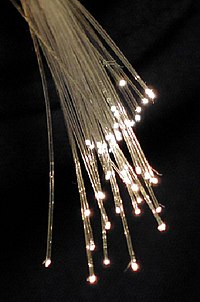
Photo from wikipedia
Abstract The doped polyaniline (PANI) mixed with divinylbenzene (DVB) as a crosslinking thermoset polymer has been presented to exemplify as a structural electromagnetic interference (EMI) shielding material. Both theoretical and… Click to show full abstract
Abstract The doped polyaniline (PANI) mixed with divinylbenzene (DVB) as a crosslinking thermoset polymer has been presented to exemplify as a structural electromagnetic interference (EMI) shielding material. Both theoretical and experimental analysis was conducted to analyze the shielding mechanisms. The effects of shielding layer thickness were studied to optimize the EMI shield properties. Preliminary studies reveal that the maximum EMI shielding effectiveness (SE) and electrical conductivity values of ∼ 20 dB in the X-band (8.2 ∼ 12.4 GHz) and 100 S/m, respectively, have been reached in the case of 1 mm thick PANI-based thermoset. It is also found from the experimental results that; absorption mechanism was the primary shielding mechanism for this material due to high conductivity. Further, both dielectric constant and permeability were estimated using Nicolson-Ross-Weir (NRW) algorithm and the S-parameters obtain from the vector network analyzer (VNA) to understand and correlate the shielding mechanisms. Finally, the PANI-based conductive layer successfully installs on structural fiber-reinforced composites to demonstrate its application as a self-EMI shielding structural composite materials. Both glass fiber reinforced polymer (GFRP) and carbon fiber-reinforced polymer (CFRP) composites were able to shield the EMI radiation with a maximum SE value of 17 and 45 dB, while keeping the layer thickness of 1 mm.
Journal Title: Composite Structures
Year Published: 2020
Link to full text (if available)
Share on Social Media: Sign Up to like & get
recommendations!